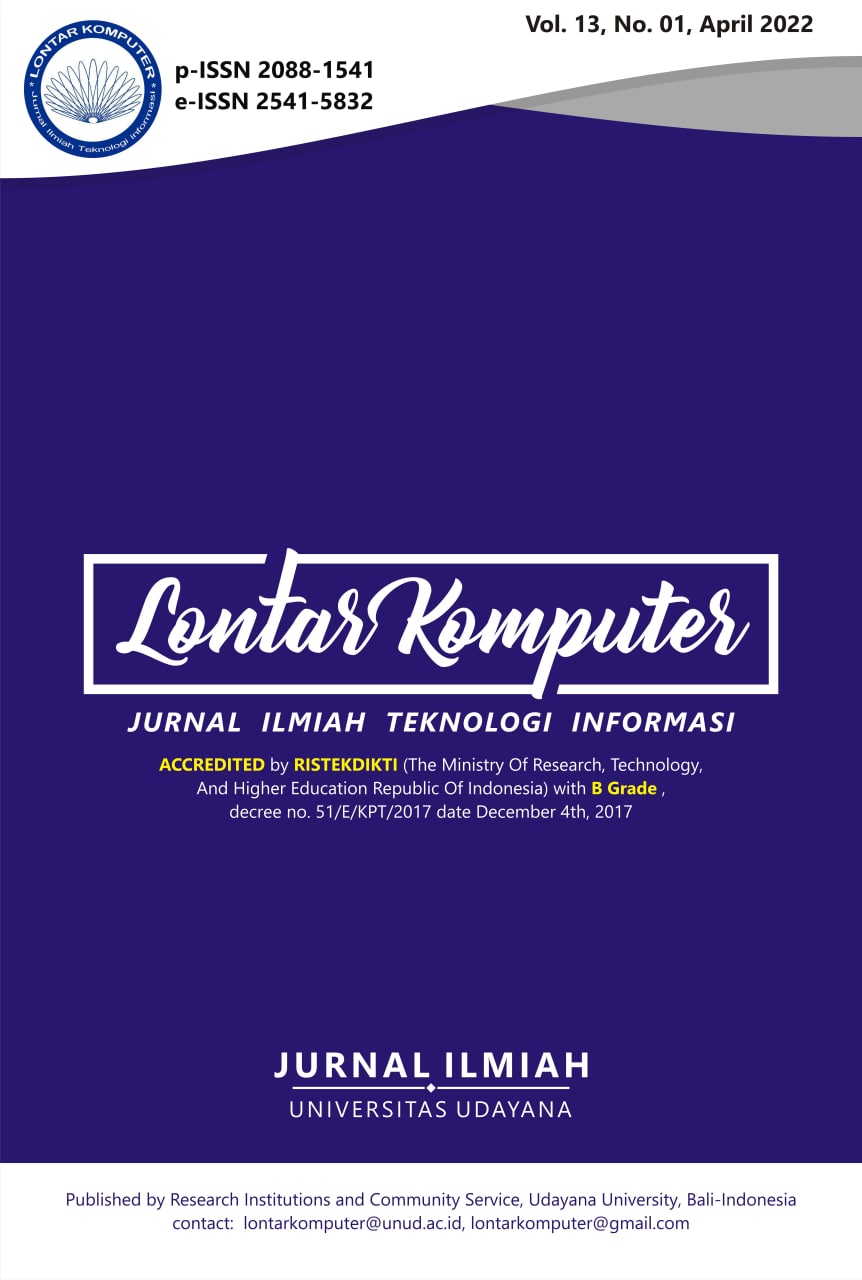Time-Series Model for Climatological Forest Fire Prediction over Borneo
Abstract
Areas covered by tropical forests, such as Borneo, are vulnerable to fires. Previous studies have shown that climate data is one of the critical factors affecting forest fire. This study aims to predict the forest fire over Borneo by considering the temporal aspects of the climate data. A time seriesbased model, Long Short-Term Memory (LSTM), is used. Three LSTM models are applied: Basic LSTM, Bidirectional LSTM, and Stacked LSTM. Three different experiments from January 1998 to December 2015 are conducted by examining climate data, Oceanic Nino Index (ONI), and Indian Ocean Dipole (IOD) index. The proposed model is evaluated by Mean Absolute Error (MAE), Root Mean Square Error (RMSE) and correlation number. As a result, all models can capture the spatial and temporal pattern of the forest fires for all three experiments, in which the best prediction occurs in September with a spatial correlation of more than 0.75. Based on the evaluation metrics, Stacked LSTM in Experiment 1 is slightly superior, with the highest annual pattern correlation (0.89) and lowest error (MAE= 0.71 and RMSE=1.32). This finding reveals that an additional ONI and IOD index as the prediction features would not improve the model performance generally, but it specifically improves the extreme event value.
Downloads
References
[2] N. Yulianti, Pengenalan Bencana Kebakaran dan Kabut Asap Lintas Batas. Bogor: IPB
Press, 2018.
[3] E. Sumarga, “Spatial indicators for human activities may explain the 2015 fire hotspot
distribution in central kalimantan indonesia,” Tropical Conservation Science, vol. 10, p.
1940082917706168, 2017.
[4] I. C. Hidayati, N. Nalaratih, A. Shabrina, I. N. Wahyuni, and A. L. Latifah, “Correlation of Climate Variability and Burned Area in Borneo using Clustering Methods,” Forest and Society,
vol. 4, no. 2, 7 2020.
[5] P. Jain, S. C. Coogan, S. G. Subramanian, M. Crowley, S. Taylor, and M. D. Flannigan, “A
review of machine learning applications in wildfire science and management,” pp. 478–505,
2020.
[6] H. Liang, M. Zhang, and H. Wang, “A Neural Network Model for Wildfire Scale Prediction
Using Meteorological Factors,” IEEE Access, vol. 7, pp. 176 746–176 755, 2019.
[7] A. L. Latifah, A. Shabrina, I. N. Wahyuni, and R. Sadikin, “Evaluation of Random Forest
model for forest fire prediction based on climatology over Borneo,” in 2019 International
Conference on Computer, Control, Informatics and its Applications (IC3INA). IEEE, 10
2019, pp. 4–8. [Online]. Available: https://ieeexplore.ieee.org/document/8949588/
[8] Z. Li, Y. Huang, X. Li, and L. Xu, “Wildland Fire Burned Areas Prediction Using Long ShortTerm Memory Neural Network with Attention Mechanism,” Fire Technology, 2020.
[9] S. Hochreiter and J. Schmidhuber, “Long Short-Term Memory,” Neural Computation, vol. 9,
no. 8, pp. 1735–1780, 11 1997.
[10] C. Gonzalez Viejo, S. Fuentes, D. D. Torrico, and F. R. Dunshea, “Non-contact heart rate and
blood pressure estimations from video analysis and machine learning modelling applied to
food sensory responses: A case study for chocolate,” Sensors, vol. 18, no. 6, p. 1802, 2018.
[11] C. Taleb, M. Khachab, C. Mokbel, and L. Likforman-Sulem, “Visual representation of online
handwriting time series for deep learning parkinson’s disease detection,” in 2019 International Conference on Document Analysis and Recognition Workshops (ICDARW), vol. 6.
IEEE, 2019, pp. 25–30.
[12] M. Wen, P. Li, L. Zhang, and Y. Chen, “Stock market trend prediction using high-order information of time series,” Ieee Access, vol. 7, pp. 28 299–28 308, 2019.
[13] J. C. B. Gamboa, “Deep learning for time-series analysis,” CoRR, vol. abs/1701.01887,
2017. [Online]. Available: http://arxiv.org/abs/1701.01887
[14] H. Lin, Y. Hua, L. Ma, and L. Chen, “Application of ConvLSTM network in numerical temperature prediction interpretation,” in ACM International Conference Proceeding Series, vol. Part
F1481, 2019, pp. 109–113.
[15] N. Wu, B. Green, X. Ben, and S. O’Banion, “Deep Transformer Models for Time
Series Forecasting: The Influenza Prevalence Case,” 1 2020. [Online]. Available:
http://arxiv.org/abs/2001.08317
[16] S. Li, X. Jin, Y. Xuan, X. Zhou, W. Chen, Y.-X. Wang, and X. Yan, “Enhancing the Locality
and Breaking the Memory Bottleneck of Transformer on Time Series Forecasting,” 6 2019.
[Online]. Available: http://arxiv.org/abs/1907.00235
[17] European Centre for Medium-range Weather Forecast (ECMWF). (2011) The erainterim reanalysis dataset, copernicus climate change service (c3s). [Online]. Available: https://www.ecmwf.int/en/forecasts/datasets/archive-datasets/reanalysis-datasets/erainterim
[18] Tropical Rainfall Measuring Mission (TRMM). (2011) Rmm (tmpa) rainfall estimate l3 3 hour 0.25 degree x 0.25 degree v7. [Online]. Available:
http://dx.doi.org/10.5067/TRMM/TMPA/3H/7
[19] L. Giglio, J. T. Randerson, and G. R. van der Werf, “Analysis of daily, monthly, and annual
burned area using the fourth-generation global fire emissions database (GFED4),” Journal of
Geophysical Research: Biogeosciences, vol. 118, no. 1, 3 2013.
[20] A. Graves and J. Schmidhuber, “Framewise phoneme classification with bidirectional lstm
networks,” in Proceedings. 2005 IEEE International Joint Conference on Neural Networks,
2005., vol. 4, 2005, pp. 2047–2052 vol. 4.
[21] R. Pascanu, C. Gulcehre, K. Cho, and Y. Bengio, “How to construct deep recurrent neural
networks,” 2013. [Online]. Available: https://arxiv.org/abs/1312.6026
[22] I. Goodfellow, Y. Bengio, and A. Courville, Deep Learning. MIT Press, 2016,
http://www.deeplearningbook.org
The Authors submitting a manuscript do so on the understanding that if accepted for publication, the copyright of the article shall be assigned to Jurnal Lontar Komputer as the publisher of the journal. Copyright encompasses exclusive rights to reproduce and deliver the article in all forms and media, as well as translations. The reproduction of any part of this journal (printed or online) will be allowed only with written permission from Jurnal Lontar Komputer. The Editorial Board of Jurnal Lontar Komputer makes every effort to ensure that no wrong or misleading data, opinions, or statements be published in the journal.
 This work is licensed under a Creative Commons Attribution 4.0 International License.
This work is licensed under a Creative Commons Attribution 4.0 International License.























